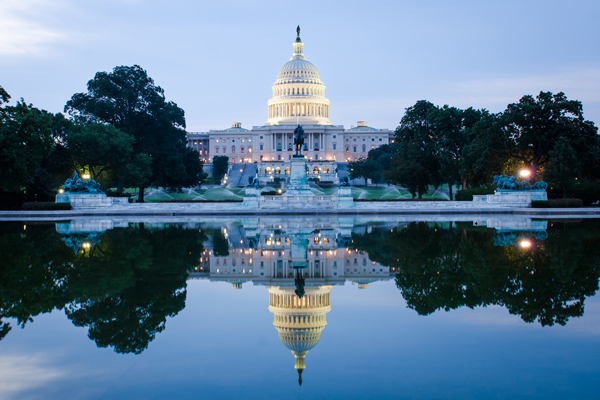Federal Funding in TexasA Vital Part of the State Budget
Federal funding plays an essential role in state finances, supporting a variety of programs and services. In fiscal 2016, for instance, nearly 20 percent of federal tax dollars went directly to state governments as grants to pay for programs in education, health care and infrastructure.

Texans sent the federal government $261 billion in taxes in 2016, and the state government received $39.5 billion in grants in return, or about 15 percent of our total federal tax tab. Those grants were the state’s second-largest revenue source, providing more than a third of its net revenue in that year. (State taxes, by contrast, supplied nearly 44 percent.)
But what determines how much we receive, and where does it go?
How Federal Funding is Distributed
According to the Office of Management and Budget (OMB), the federal government received more than $3.2 trillion in total taxes in 2016. Of that, $1.5 trillion or 47 percent came from personal income taxes, which in 2018 are expected to comprise more than half of all federal revenue for the first time in our nation’s history.
After taxes are collected, they’re appropriated to various federal agencies, some of which then allocate funding to individuals and state and local governments.
The largest share of federal aid represents direct payments to individuals for Social Security, disability, Medicare, unemployment compensation and other programs. But these payments don’t flow through state governments.
Some grants to states are based on formulas, such as block and categorical grants, while others are awarded on a competitive basis, such as highway project grants. Block grants such as Temporary Assistance for Needy Families (TANF) have relatively few “strings” attached, meaning states have broad latitude in using the money; categorical grants, such as those for the Head Start program, are more restrictive. States must follow each grant program’s guidelines to continue receiving funds. And some grant programs, such as Medicaid, require the state to contribute matching funds.
Much of federal funding to states is driven by population. The most populous states receive more money simply because they’re larger and have more people in need of services. For this reason, federal funding to the states often is examined on a per capita basis.
Federal funding also can vary due to each state’s specific circumstances. Military bases, national parks, federal offices and the occurrence of natural disasters all can help determine how much federal funding a state receives in any given period.
The different types of grant programs also can account for variability in federal funding. Grants for community development usually rise after natural disasters, while competitive grants by their very nature mean that some states won’t receive as much as others.
Medicaid, one of the largest aid programs, is linked to personal income. Each state’s share is determined by its Federal Medical Assistance Percentage (FMAP), set annually based on per capita income. By federal law, the FMAP must be at least 50 percent; for federal fiscal 2018, Texas’ FMAP is 56.88 percent, meaning that the federal government will pay a larger share of Texas’ Medicaid funding than the state. Similarly, poverty rates determine needs-based funding for programs such as TANF.
Comparing the States
OMB reports state governments received federal grants totaling more than $661 billion in 2016. The Comptroller’s most recent Annual Cash Report estimated that 35.5 percent of Texas’ net revenue for fiscal 2016 came from the federal government (Exhibit 1).
Exhibit 1: Percentage of Net Revenue by Source, All Funds Excluding Trust, Fiscal 2016
Source: Texas Comptroller of Public Accounts
From 2000 to 2015, federal funds comprised between 29.9 and 40.8 percent of all Texas state revenue, and averaged about 34 percent (Exhibit 2). The federal share in all states tends to rise during recessionary periods and decline in better economic times. In each year of the period, however, Texas’ reliance on federal funds was higher than the average among states.
Exhibit 2: Federal Share of State General Revenue, Texas vs. 50-State Average, 2000-2015
| Year | Texas Share | 50-State Average Share |
|---|---|---|
| 2000 | 29.9% | 26.3% |
| 2001 | 29.8% | 27.5% |
| 2002 | 33.4% | 29.9% |
| 2003 | 35.5% | 30.9% |
| 2004 | 34.8% | 31.3% |
| 2005 | 34.1% | 30.0% |
| 2006 | 33.3% | 28.6% |
| 2007 | 31.1% | 28.1% |
| 2008 | 29.8% | 27.8% |
| 2009 | 35.7% | 31.8% |
| 2010 | 40.8% | 35.5% |
| 2011 | 39.4% | 34.7% |
| 2012 | 34.5% | 31.7% |
| 2013 | 32.6% | 30.4% |
| 2014 | 31.8% | 30.7% |
| 2015 | 33.4% | 31.9% |
Source: Pew Charitable Trusts
According to Pew Charitable Trusts, in fiscal 2015 Louisiana was the most dependent on federal funds, at 42.2 percent of total revenues, while North Dakota had the lowest at 18.4 percent.
On a per capita basis, however, the picture looks considerably different. In fiscal 2016, Texas ranked 43rd among states in federal funds per resident, receiving $1,493, well below the national average of $1,871 (Exhibit 3).
Exhibit 3: Federal Grants Received Per Capita, Fiscal 2016
| Top 10 States | Per Capita Amount |
|---|---|
| Alaska | $3,700 |
| New Mexico | $3,225 |
| Vermont | $3,100 |
| Wyoming | $3,044 |
| New York | $2,854 |
| West Virginia | $2,699 |
| Kentucky | $2,671 |
| Rhode Island | $2,556 |
| Oregon | $2,492 |
| Arkansas | $2,466 |
| Bottom Ten States | Per Capita Amount |
|---|---|
| Virginia | $1,081 |
| Utah | $1,203 |
| Florida | $1,228 |
| Nebraska | $1,287 |
| Kansas | $1,297 |
| Georgia | $1,372 |
| Nevada | $1,477 |
| TEXAS | $1,493 |
| Colorado | $1,496 |
| New Hampshire | $1,499 |
Source: Federal Funds Information for States
What do the federal grants pay for?
Today, health care dominates federal grants to state and local governments. In 1980, health care received only 17.2 percent of these grants, but this share rose to 43.7 percent by 2000 and 60 percent by 2016 (Exhibit 4).
This increase has been driven largely by rising costs for Medicaid, which accounts for more than 90 percent of all federal health care spending.
Exhibit 4: Federal Grants to State and Local Governments by Category, 2000-2016
| Category | HEALTH CARE | INCOME SECURITY* | EDUCATION | TRANSPORTATION | OTHER |
|---|---|---|---|---|---|
| 2000 | 43.67% | 24.02% | 12.83% | 11.27% | 8.21% |
| 2001 | 43.73% | 23.88% | 12.6% | 11.5% | 8.29% |
| 2002 | 44.96% | 23.1% | 12.7% | 11.62% | 7.62% |
| 2003 | 44.73% | 22.26% | 13.27% | 10.56% | 9.18% |
| 2004 | 46.59% | 21.1% | 13.3% | 10.18% | 8.83% |
| 2005 | 46.22% | 21.23% | 13.37% | 10.13% | 9.03% |
| 2006 | 45.46% | 20.69% | 13.94% | 10.75% | 9.15% |
| 2007 | 46.94% | 20.5% | 13.09% | 10.8% | 8.67% |
| 2008 | 47.26% | 20.83% | 12.77% | 11.1% | 8.04% |
| 2009 | 49.87% | 19.18% | 13.75% | 10.3% | 6.89% |
| 2010 | 47.69% | 18.93% | 16.04% | 10.02% | 7.31% |
| 2011 | 48.26% | 18.73% | 14.69% | 10.05% | 8.27% |
| 2012 | 49.26% | 18.84% | 12.51% | 11.16% | 8.23% |
| 2013 | 51.82% | 18.71% | 11.48% | 11.08% | 6.91% |
| 2014 | 55.47% | 17.48% | 10.48% | 10.79% | 5.78% |
| 2015 | 58.95% | 16.19% | 9.69% | 9.74% | 5.43% |
| 2016 | 60.03% | 15.85% | 9.21% | 9.66% | 5.24% |
* Includes social services and training and employment programs.
Source: U.S. Office of Management and Budget
In Texas, more than 95 percent of federal grants received in fiscal 2016 went to three functional areas of government: health and human services; public and higher education; and business and economic development, primarily highways and transportation (Exhibit 5).
Exhibit 5: Federal Grants to Texas by Category, Fiscal 2016
Source: Legislative Budget Board
Medicaid received more funding than any other single program — $24 billion in fiscal 2016, according to the Legislative Budget Board, or more than half of all federal funding for health and human services in Texas.
The National Highway Performance Program, which builds and maintains roads in the National Highway System, received the second most grant funds in Texas, with $2 billion. FN
To learn more about federal funding in Texas, visit the Legislative Budget Board and read Top 100 Federal Funding Sources in the Texas State Budget. (PDF)
Related:
- “Local Funds” and State Finances (August 2017)
- State Agencies and “Legacy” Systems (December 2017/January 2018)
- The Treasury Operations Division (August 2017)
- Tax Volatility (November 2016)
- The Fiscal Noting Process (November 2016)


